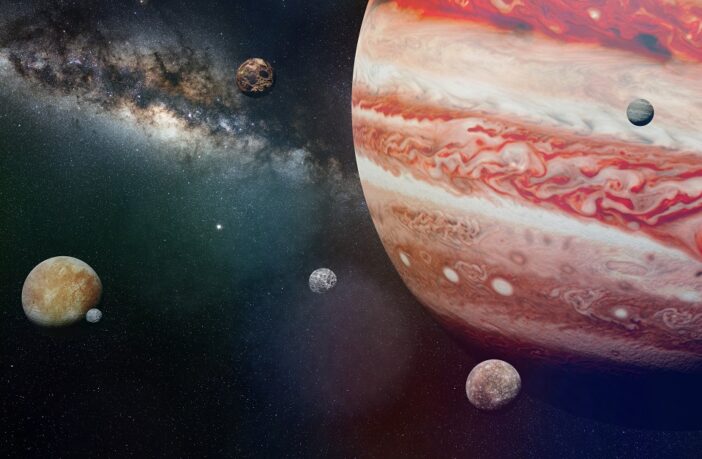UK scientists and engineers, including from The Open University (OU) are taking part in a mission that’s about to set off to study Jupiter, our largest planet, and investigate whether some of its icy moons are home to conditions that could support life.
Funded by the UK Space Agency, the UK leads on one of the 10 science instruments on board the European Space Agency’s Jupiter Icy Moons Explorer (JUICE) and has contributed to the development of two more.
Due to take off on Thursday* (13 April 2023), JUICE will spend eight years travelling to the Jupiter system. On the way, it will perform fly-bys of Earth and Venus, using the gravitational fields of the planets to generate enough speed to reach Jupiter. One of these will be the first ever lunar-Earth gravity assist manoeuvre.
Dr Chiaki Crews, Research Fellow at the OU, worked with a team in preparation for the JUICE mission, testing and improving cameras:
“The JUICE mission aims to answer many exciting questions, including whether the ocean worlds beneath the surfaces of Jupiter’s icy moons could potentially harbour life. One of the many instruments needed to make detailed scientific observations to help answer such questions is a camera.
“Our team at the Open University has spent several years testing and optimising a new image sensor for JUICE’s scientific camera, JANUS. A large part of our work was to irradiate test sensors with high doses of radiation, just like it is expected to experience during the JUICE mission lifetime, to check that JANUS will still be able to take images without too much degradation.
Andrew Holland Professor of Electro-Optics at the OU, added:
“Our involvement in the JUICE helped us to take super new technology which was being developed by industry and to turn it into a product with real-world benefit and applications. The new image sensors developed for JANUS on JUICE represent the first use in space of this new sensor technology; specifically designed to withstand the ultra-harsh radiation environment to be encountered around Jupiter”
On arrival in 2031, JUICE will circle Jupiter and fly past moons Ganymede, Europa and Callisto, making observations and taking measurements, studying the Jovian system as an archetype for gas giants elsewhere in the universe.
Finally in December 2034, JUICE will transfer into orbit around Ganymede, becoming the first spacecraft ever to orbit a moon other than Earth’s. While up close and personal with Ganymede, the mission will investigate the giant ocean that scientists believe hides under its icy crust, seeking evidence of habitability.
Dr Caroline Harper, Head of Space Science at the UK Space Agency, said:
“The launch of JUICE marks years of hard work and collaboration by scientists, engineers and space agencies all over the world, but the journey is far from over.
“We look forward to following the spacecraft as it makes its eight-year trip to Jupiter and then as it studies the planet and its moons, using specialised UK-developed science instruments.
“We have a large community of research experts in the UK who are eagerly awaiting the data that JUICE will provide. With this information we hope to discover more about the nature of gas giants in space, and their icy moons, bringing us another step closer to understanding the evolution of the Universe.”
The UK Space Agency invested £9 million into the JUICE science payload, by supporting three critical instruments on board, including JANUS (Italian-led optical camera system) – Imaging sensors developed by Teledyne-e2v in the UK, then tested, calibrated and characterised by the OU.
After taking off on an Ariane 5 launch vehicle from Kourou in French Guiana it is expected to arrive at Jupiter in July 2031 and complete 35 icy moon flybys before arriving at Ganymede – the largest of Jupiter’s moons – by December 2034.
JUICE will spend its eight-year voyage productively; it will pass by Venus to test and calibrate its instruments, gather data and take advantage of the gravity assist to save on fuel. Meanwhile, scientists on the ground will work on finalising software and data modelling in time for arrival at Jupiter.
Dr Crews added:
“We are now very much looking forward to watching the launch, albeit we’ll have to wait patiently for several more years before we’ll see the first images sent back from Jupiter’s moons.”
*following publication the launch was delayed by a day due to weather conditions and took place on 14 April 2023.



